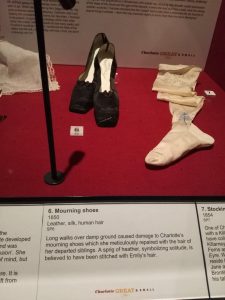Just when you thought the Bronte sisters could not get any more gothic Charlotte Bronte’s silk shoes from 1850 reveal that she repaired them using her dead sibling’s hair!! This may seem maudlin to us but it was evidently an act of great love for Charlotte and a symbol of her immeasurable loss. She stitched the hair (thought to be Emily’s) into a sprig of heather symbolising solitude. It shows that she was familiar with the Victorian Language of Flowers, something I have written about in my botany book. It is a nod perhaps too to Emily’s gothic heroine Catherine who died whilst Heathcliff was out gathering heather for her on the moor. How could any one not imagine unquiet slumbers for the sleepers in that quiet earth!

If you have not been to the Bronte Parsonage Museum in Howarth you will not be disappointed and should still find the reference to the shoes in the display case there. Thank you to @bookwitchsara for the image and for reminding me about this story. I am posting it for my niece Miranda who specialises in clothing and collects Victorian mourning wear involving hair (that is rings and lockets etc. containing hair; worn following the death of a loved one). Such love tokens always remind me of visiting Keats’s house where you can see the lock of hair Fanny Brawne sent to the poet in a letter before his untimely death in Italy in 1821. I am also reminded of ‘The Relic’ by John Donne. Here the poet muses on the bracelets of hair the lovers wore when buried, as a symbol of their eternal love. Donne imagines them as religious icons (whilst knowing that the hair was a symbol of earthly rather than divine love). I imagine Charlotte would enjoy the sentiment in this poem whilst remaining devout (though the siblings were known for their liking of Scott).
When my grave is broke up again
Some second guest to entertain [..],
And he that digs it, spies
A bracelet of bright hair about the bone,
Will he not let’ us alone,
And think that there a loving couple lies,
Who thought that this device might be some way
To make their souls, at the last busy day,
Meet at this grave, and make a little stay?
If this fall in a time, or land,
Where mis-devotion doth command,
Then he, that digs us up, will bring
Us to the bishop, and the king,
To make us relics; then
Thou shalt be a Mary Magdalen, and I
A something else thereby;
All women shall adore us, and some men;
And since at such time miracles are sought,
I would have that age by this paper taught
What miracles we harmless lovers wrought.
First, we lov’d well and faithfully,
Yet knew not what we lov’d, nor why;
Difference of sex no more we knew
Than our guardian angels do;
Coming and going, we
Perchance might kiss, but not between those meals;
Our hands ne’er touch’d the seals
Which nature, injur’d by late law, sets free;
These miracles we did, but now alas,
All measure, and all language, I should pass,
Should I tell what a miracle she was.

That is incredible! It’s so symbolic of the need we have for one another to the point beyond death but in physical form, and part of someone, who is departed, still creating help and strength in the very steps we walk. Thank you.
yes, I find it very moving and tragic as it shows that she was the last one and so alone without her remarkable siblings.
Sam: there’s a lock of Emily’s hair on display in the Parsonage Museum. Also Anne’s handkerchief speckled with blood (sic) from her tubercular coughing. The latter is literally hair-raising.
Thanks yes I had forgotten that too. The speckled handkerchief sounds perfect for the Books of Blood show. Keats also coughed up blood of course and wrote about it in his letters as his ‘death warrant’. Lots of ideas around blood and sensibility….